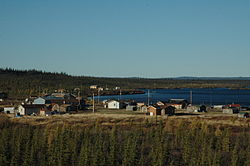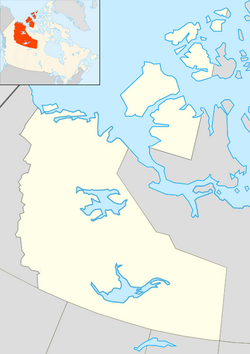Colville Lake, Northwest Territories
|
Colville Lake K'áhbamį́túé |
|
|---|---|
| Settlement Corporation | |
 |
|
| Coordinates: 67°02′18″N 126°05′32″W / 67.03833°N 126.09222°WCoordinates: 67°02′18″N 126°05′32″W / 67.03833°N 126.09222°W | |
| Country | Canada |
| Territory | Northwest Territories |
| Region | Sahtu Region |
| Constituency | Sahtu |
| Census division | Region 2 |
| First Nation (Designated Authority) | 30 November 1995 |
| Government | |
| • Chief | Alvin Orlias |
| • Senior Administrative Officer | Joseph Kochon |
| • MLA | Norman Yakeleya |
| Area | |
| • Land | 128.39 km2 (49.57 sq mi) |
| Elevation | 259 m (850 ft) |
| Population (2011) | |
| • Total | 149 |
| • Density | 1.2/km2 (3/sq mi) |
| Time zone | Mountain (MST) (UTC-7) |
| • Summer (DST) | MDT (UTC-6) |
| Canadian Postal code | X0E 1L0 |
| Area code(s) | 867 |
| Telephone exchange | 709 |
| - Living cost | 177.5 |
| - Food price index | 202.8 |
| Sources: Department of Municipal and Community Affairs, Prince of Wales Northern Heritage Centre, Canada Flight Supplement ^A 2009 figure based on Edmonton = 100 ^B 2010 figure based on Yellowknife = 100 |
|
Colville Lake (K'áhbamį́túé meaning "ptarmigan net place") is a settlement corporation located in the Sahtu Region of the Northwest Territories, Canada. The community is located 50 km (31 mi) north of the Arctic Circle, on a lake of the same name, and is northeast of Norman Wells. This settlement is the administrative office of the Behdzi Ahda band government.
Population is 149 according to the 2011 Census, an increase of 18.3% over the 2006 Census. In 2012 the Government of the Northwest Territories reported that the population was 157 with an average yearly growth rate of 2.9% from 2001. The GNWT also reported that the majority, 139 people, were Aboriginal, Sahtu Dene. They are represented by the Behdzi Ahda First Nation and belong to the Sahtu Dene Council
Colville Lake is located 745 km (463 mi) by air northwest of Yellowknife. The terrain is characterized by black spruce and tends to be small and sparse. Other vegetation includes mosses, lichens, grasses and alders. The winter months begin in October and last until April. The month of May is considered the spring or breakup period. By the end of May or Early June the lakes and rivers are normally free of ice, although this varies. June, July and August are considered the summer months and temperatures range in the mid twenties. At times the temperature has climbed into the low thirties. By late September, freeze up is well underway again.
The community of Colville Lake is the ancestral homeland of the Hareskin Dene who still inhabit the area. The Hareskin Dene were never very numerous, with a population of less than one thousand people, living in six or seven bands, at the time of European contact. The Hareskins were a peaceful group, known for their use of small animals such as the Arctic hare. Located within the traditional homeland of the North Slave Dene tribe, Colville Lake is a completely traditional community in every sense. Although Father Émile Petitot brought Christianity to the area in 1864, organization of the community did not occur until 1962 when a Roman Catholic mission was established.
...
Wikipedia

